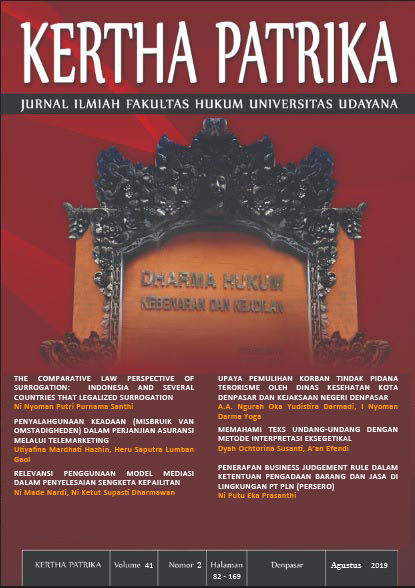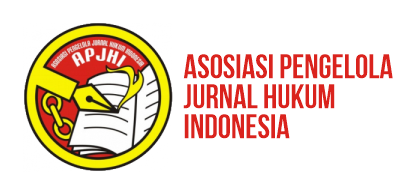Memahami Teks Undang-Undang dengan Metode Interpretasi Eksegetikal
Abstract
Penelitian ini menganalisis metode interpretasi eksegetikal untuk memahami teks undang-undang. Fokus penelitian pada isu hukum bagaimana memahami teks undang-undang dengan metode interpretasi eksegetikal. Tipe penelitian yang digunakan adalah penelitian doktrinal dengan pendekatan konseptual yaitu pendekatan yang bertumpu pada pandangan, gagasan, dan doktrin yang berkembang dalam ilmu hukum. Hasil penelitian ini bahwa menunjukkan bahwa interpretasi diperlukan untuk memahami teks undang-undang yang tidak jelas karena memuat norma terbuka, norma yang ambigu, norma kabur, dan norma yang bertentangan. Selain itu, tulisan ini menyimpulkan bahwa metode interpretasi eksegetikal melihat teks undang-undang untuk diinterpretasi makna logisnya dengan menggunakan tiga elemen: interpretasi gramatikal, interpretasi logis, dan interpretasi sejarah.
Downloads
References
Barak, A. (2005). Purposive Interpretation in Law. Princenton: Princenton University Press.
Bradley, A.W, & Ewing, K.D. (2007). Constitutional and Administrative Law. 14th Edition. Edinburgh Gate: Pearson Education Limited.
Bruggink, JJ. (2011). Refleksi Tentang Hukum Pengertian-Pengertian Dasar dalam Teori Hukum. Alih Bahasa Sidharta, B.A. Bandung: Citra Aditya Bakti.
Busch, D. (Ed). (2002). The Principle of European Contract Law and Dutch Law. Nijmagen: An Acqui Libri & The Haque: Kluwer Law International.
Bussmann, H. (1998). Routledge Dictionary of Language and Linguistics. Translated and Edited by Trauth, G, & Kazzazi, K. London and New York: Routledge.
Crabbe, V.C.R.A.C. (1994). Understanding Statutes. London: Cavendish Publishing Limited.
Crabbe, V.C.R.A.C. (1994). Legislative Drafting. London: Cavendish Publishing Limited.
Droga, Louise & Sally Humprey. (2005). Grammar and Meaning An Introduction for Primary Teachers. New South Wales: Targer Texts.
Endicott, T.A.O. (2005). The Value of Vagueness. Dalam Bhatia, V.K. et.al (Eds). Vagueness in Normative Texts. Bern: Peter Lang.
Hage, J, & Akkermans, B. (Eds). (2014). Introduction to Law. Dordrecht: Springer.
Hazen, K. (2015). An Introduction to Language. West Sussex: John Wiley & Sons.
Hutchinson, T. (2002). Researching and Writing in Law. Pyrmont NSW: Lawbook Co.
Kelsen, H. (2011). Hukum dan Logika. Alih bahasa Sidharta, B.A. Bandung: Alumni
Lieber, F. (1839). Legal and Politic Hermeneutics, or Principles of Interpretation and Construction in Law and Politics with Remarks on Precedents and Authorities. Boston: Charles C. Little and James Brown.
Pattaro, E. (2007). A Treatise of Legal Philosophy and General Jurisprudence: Volume 1: The Law and The Right. Dordrecht: Springer Science & Business Media.
Putman, W. H. (1998). Legal Analysis and Writing for Paralegals. Albany, NY: West Publishing.
Mertokusumo, S. (2007). Penemuan Hukum Suatu Pengantar. Yogyakarta: Liberty.
Yan, L. (2005). The Systematic Functional Approach to the Legal Text, dalam Le, C. et.al, Proceeding of the Fifth International Conference on Law, Language and Discourse. Sept.27-Oct.1, 2005, Örebro University, Sweden. United States of America: The American Scholars Press.
Willem, K. (2009). The Limits of the Law of Obligations. Dalam Claes, E, Devroe, W, & Keirsbilck, B (Eds). Facing the Limits of the Law. Heidelberg: Springer.
Jurnal
Akshaya, G.V. (2017). Court and Intention of Legislature Enacting the Statute. IOSR Journal of Humanities and Social Science, 22 (9), 96-100.
De Sloovere, F. J. (1936). Contextual Interpretation of Statutes. Fordham Law Review, 5(2), 219-239.
Enggarani, N.S. (2018). Independensi Peradilan dan Negara Hukum. Jurnal Law and Justice, 3 (2), 82-90.
Germain, C. M. (2003). Approaches to Statutory Interpretation and Legislative History in France. Duke Journal of Comparative & International Law, 13 (195), 195-206.
Gibbons, J. (1999). Language and the Law. Annual Review of Applied Linguistic, 19, 156-173.
Grissel, K.D. (2017). The Legal Fiction of "Clear Text" in Willis-Knighton v. Caddo-Shreveport Sales and Use Tax Commission. Louisiana Law Review, 67(2), 523-569.
Grossfield, B. (1985). Language and the Law. Journal of Air Law and Commerce, 50(4), 793-803.
Keith, K.J. (2009). Interpreting Treaties, Statues and Contracts. Occasional Paper New Zealand Centre for Public Law, 19, 1-56.
Robbins, I.P. (2018). “And/Or” and the Proper Use of Legal Language. Maryland Law Review, 77 (2), 311-337.
Stack, K.M. (2012). Interpreting Regulations. Michigan Law Review, 111 (3), 355-422.
Telep, N. (2016). Staying Out of Treble: A Comprehensive Civilian Approach to the Lousiana Mineral Code Provisions on Damage for Unpaid Royalties. Lousiana Law Review, 76 (3), 995-1024.
Waldron, J. (1994). Vagueness in Law and Language: Some Philosophical Issues. California Law Review, 82 (3), 509-540.
Walshaw, C. (2019). Recent Developments in Statutory and Constitutional Interpretation. Statuta Law Review, 40 (1), 1-12.
Disertasi
Walshaw, C.J. (2012). Interpretation of Statutory Rules as Application: A Legal Hermeneutics. The University of Otago.
Website
Endicott, T. (2016). Law and Language. Retrieved from https:plato.stanford.edu/entries/law-language/Fri Apr 15, 2016, diakses 1 Maret 2019.
Endicott, T, Law and Language, in https:plato.stanford.edu/entries/law-language/Fri Apr 15, 2016, accessed 1 st March 2019.
https://www.encyclo.nl>begrip>open%20norm, diakses 5 Maret 2019.
https://www.merriam-webster.com/dictionary/interpretation, diakses 1 Maret 2019.
https://www.merriam-webster.com/dictionary/interpret, diakses 1 Maret 2019.
Kamus
Garner, B.A. (Editor in Chief). (2004). Black's Law Dictionary. St. Paul, Miinesota: Thomson West.
Lewis, CT, & Short, C. (1958). Latin Dictionary. Oxford: The Clarenson Press.
Martin, H.M. (1991). Oxford Learner’s Pocket Dictionary. New Edition. Oxford: Oxford University Press.











